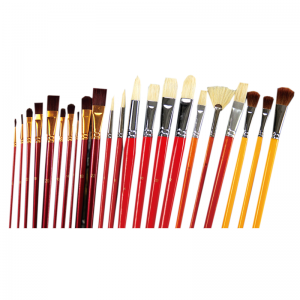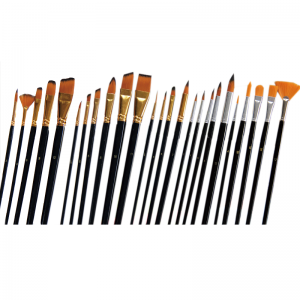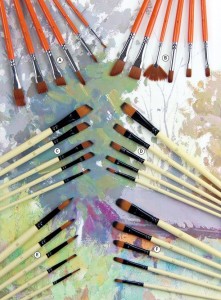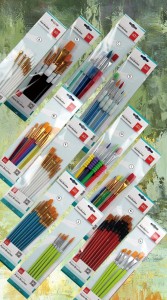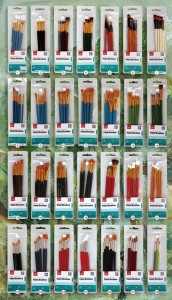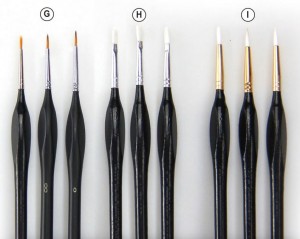Artist Brushes introduce
In 2002, Apsis established a brush joint venture,which by now has a 21-year production history. With new-style package, good quality and competitive price, Apsis gains popularity among the customers.
We can produce different sorts of brushes according to customer's samples and requirements.Good quality,competitive price and perfect after-sale service are our consistent aims.
We will make great success through our joint &unremitting efforts. The customers' satisfactionis our biggest success.
We sincerely hope to build long business relationships with importers worldwide and cooperate with brother manufacturers of artist materials.
We sincerely invite you to visit Apsis and give instructions.

Hair Type
The quality and availability of a natural hair affects the price of a brush. The mixture of different diameters of synthetic filaments also determines the cost, as each filament is individually extruded
| hair type | density |
| Pony | Soft Natural Bristle |
| Fitch | Soft Natural Bristle |
| Camel | Soft Natural Bristle |
| Sable | Soft Natural Bristle |
| Squirrel | Soft Natural Bristle |
| Ox | Medium Natural Bristle |
| Goat | Soft Natural Bristle |
| Boar or Hog | Stiff Bristle |
| Synthetic, Multi-Diameter | Soft to Medium |
| Nylon | Medium to Stiff |
| Synthetic Bristle | Stiff |
Ferrule Type
The ferrule is one of the most important parts of the brush because it holds the bristles and connects all parts of the brush. Best quality ferrules can represent up to one-third the cost of the brush.
| Ferrule | Benefits |
| Plated Brass | The highest quality ferrule, nickel, copper,gold or black plated brass represent the most durable ferrule. They are used on best quality brushes. They do not rust and will not deform easily. |
| Aluminum | Seamless aluminum ferrules are rust proof and will not allow solvent to affect the brush head.
An aluminum ferrule is softer than brass and as a result can be deformed more easily |
| Plastic | A plastic ferrule is typically used for disposable brushes |
Handle Length
The type of medium used and the amount of small detail being painted determines the choice of handle length
Handle Type
The handle type can determine the cost and durability of a paint brush
| Handle length | Uses |
| Standard(Length abt.15cm-20.5cm) | Also known as watercolor length. This brush length is ideal if you like to work close to your painting |
| Long/Easel(Length abt.24cm up) | Used for oil and acrylic painting at an easel. A long handle brush allows the artist to step back from the painting to get a better perspective of what is being painted |
| Short(Length abt.12cm-16cm) | Usually used on craft brushes or brushes designed for children. Allows the artist to be closer to their work for more control |
| Ultra Short/Mini(Length abt.6cm-12cm) | An ultra short brush handle is best for very small detail work. This brush length is ideal for miniatures and models |
| Handle type | Benefits |
| Acrylic | Best for water-based mediums. It will notabsorb water and therefore will not expand and contract. The beveled end is used for burnishing, scraping, and removing color.Very durable. |
| Hardwood | Assures that brush heads stay firmly crimped |
| Polymer | Economical, excellent for water based mediums as it will not absorb water. Very durable |

BRUSH STORAGE AND CARE TIPS
1. Acrylic brushes should be stored flat, but can be stored upright if most of the water has been dried from the hairs.
2. Wood handle brushes should always be stored flat or hanging down to prevent water from soaking into the handle.
3. When storing natural hair brushes for the summer or long periods, dip the brushes in liquid hand or dish soap, wipe the excess, reshape the head, and allow the brush to dry. This will seal the hairs, eliminate mites from getting to the brush, and ensure the brush head keeps its shape.
4. While brushes are not made to last forever, good care can help extend their life time significantly.
· If acrylic paints dry in the hairs, the brush may be ruined, the hairs permanently damaged.
· Try not to soak handles. Water levels should only be to the crimping on the ferrule. Wetting handles will cause cracking and loosening of the ferrules. Dry handles after every cleaning.
Cleaning Brushes
· Clean immediately after painting. Do not let any paint sit or dry in the hairs.
· You can clean the brushes with regular hand soap, reshape and let dry.
Water-based media: Rinse the brush several times in clean water. Lather (use a good brush cleaner) up the brush and swirl it around in the palm of your hand, then rinse; continue until all of the rinse water is colorless and all of the cleaner is removed.
Other media: Rinse the brush in solvent until all of the color is removed. Wipe the brush back and forth on paper towel or rags to work the solvent throughout the brush and remove all color



